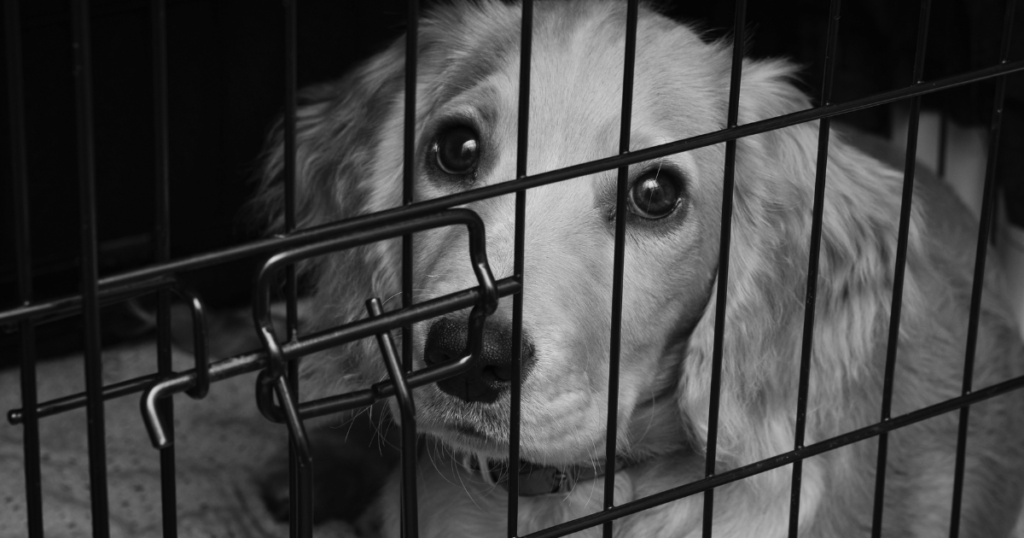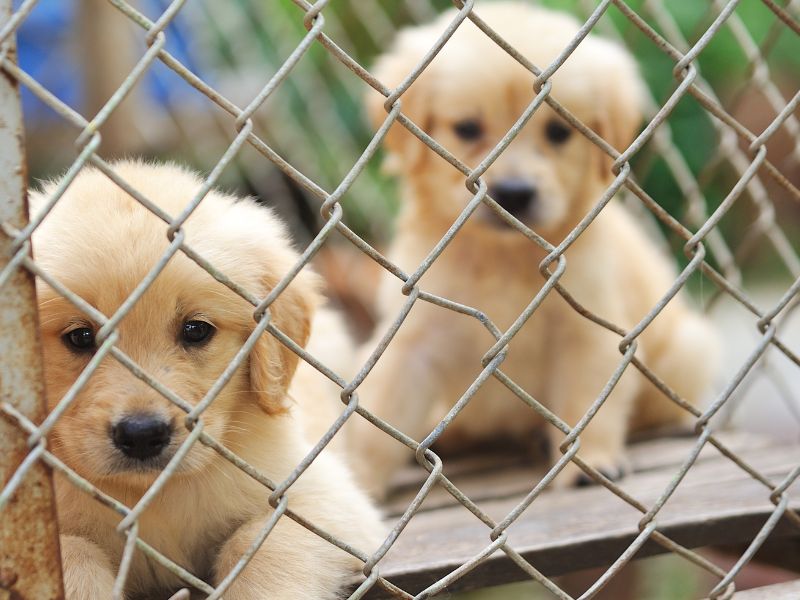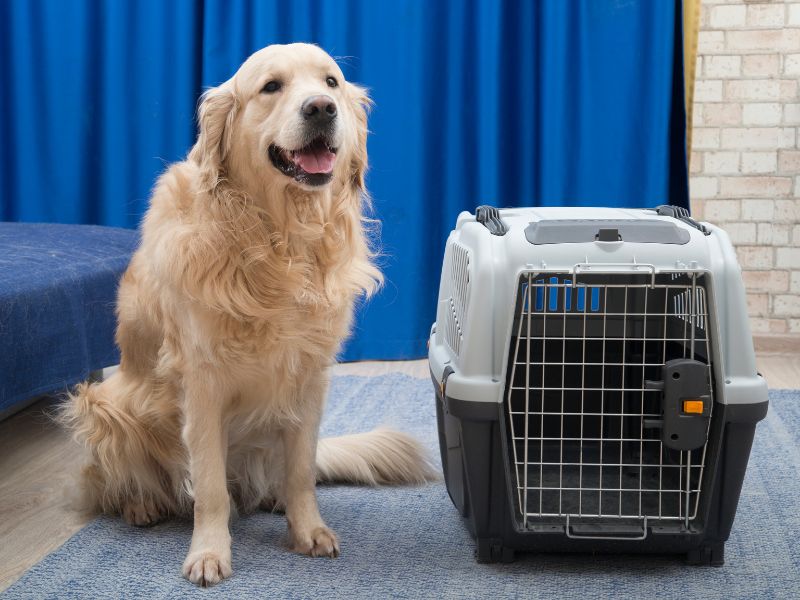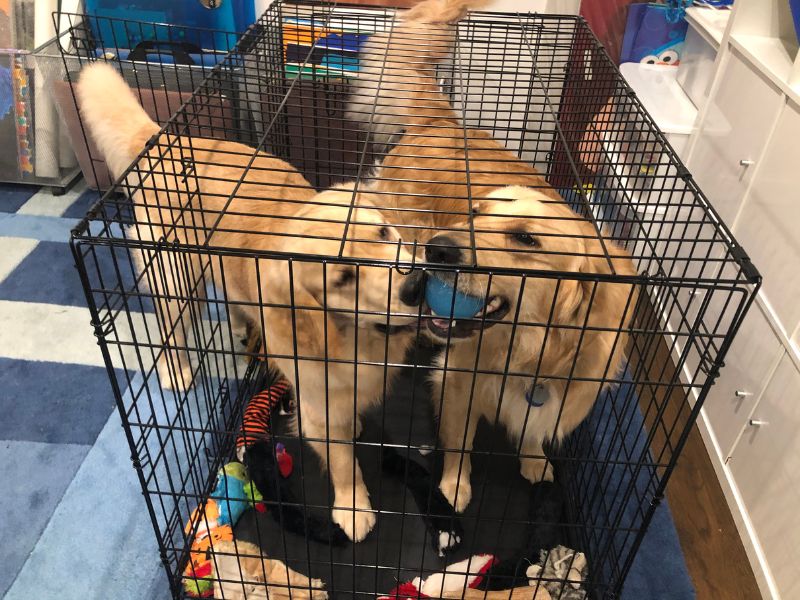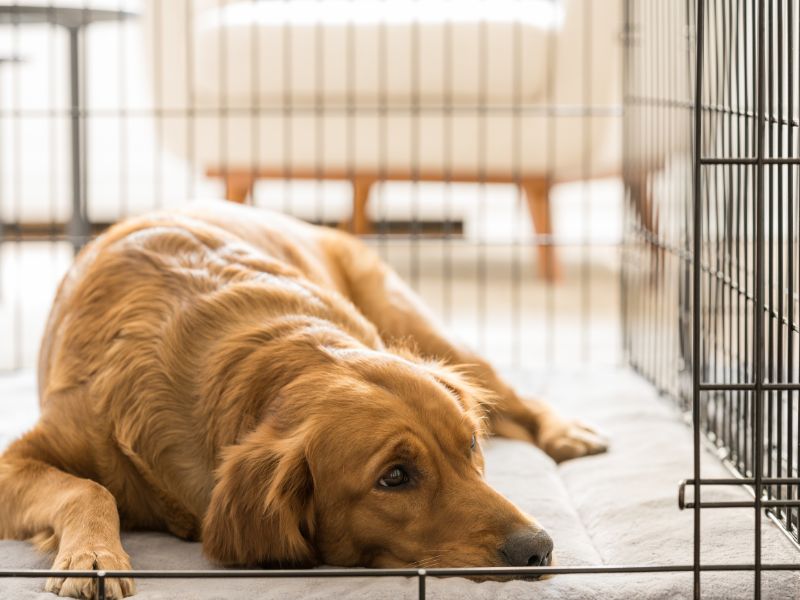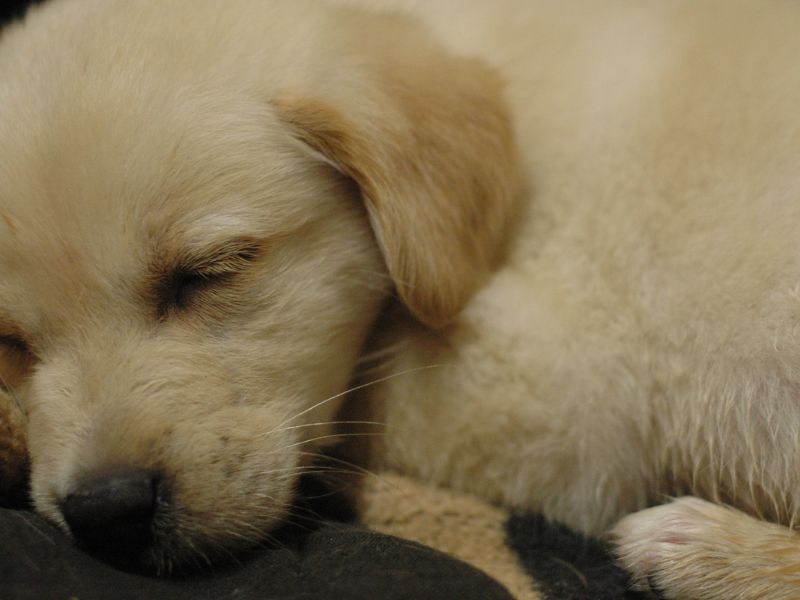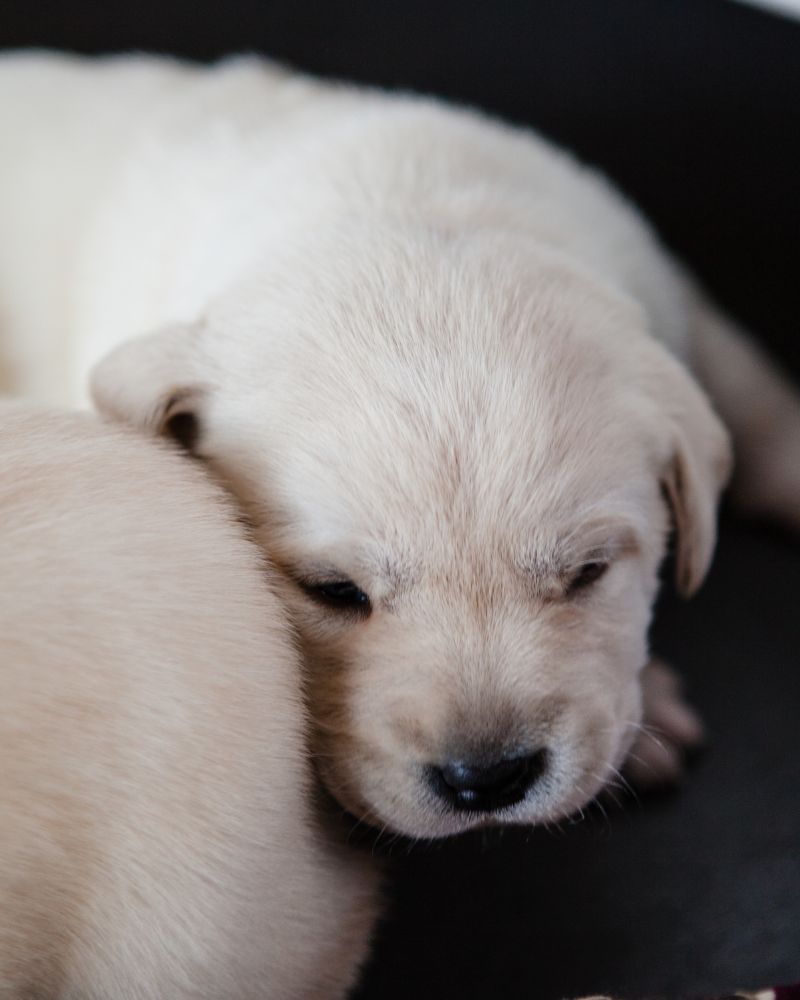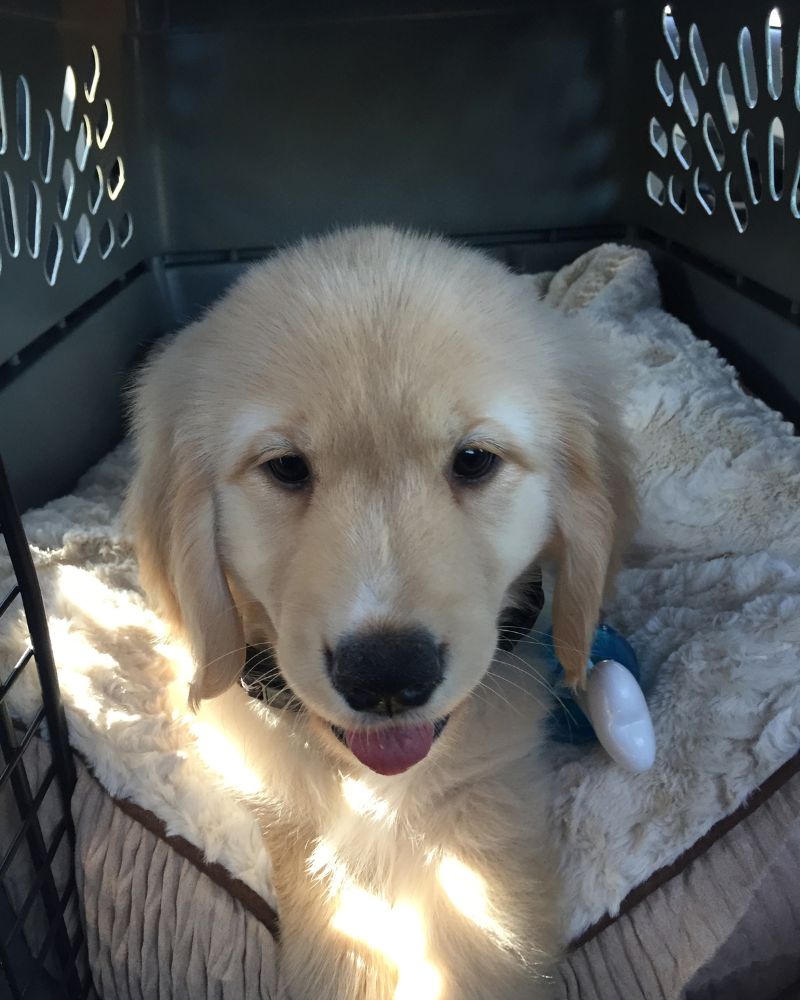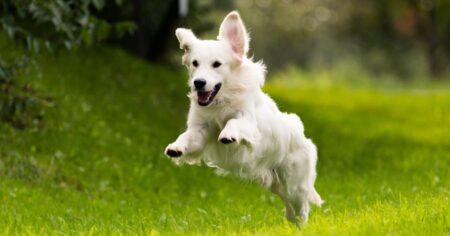Crate training is a popular method of housebreaking puppies, and Golden Retrievers are no exception. While some people may view crate training as cruel or inhumane, when done correctly, it can actually be a very effective and humane tool for both puppy and owner. Crate training can help with potty training, keep your puppy safe and secure when you’re not home, and provide a comfortable and familiar space for your puppy to relax in.
When first introducing your Golden Retriever puppy to their crate, it’s important to make it a positive experience. Start by placing treats and toys inside the crate, and allowing your puppy to explore it on their own. Once your puppy is comfortable going in and out of the crate, start feeding them their meals inside the crate, with the door open. Gradually increase the amount of time your puppy spends in the crate with the door closed, starting with just a few minutes at a time and gradually working up to longer periods. With patience and consistency, your Golden Retriever puppy can become comfortable and even enjoy spending time in their crate.
Why You Should Crate Train Your Golden Retriever
Crate training is an essential part of raising a well-behaved and disciplined Golden Retriever puppy. While some people may view crates as cruel or inhumane, they actually provide a safe and secure space for your puppy to call their own.
Crate training can help with potty training, as puppies are less likely to soil their sleeping area. It also helps prevent destructive behavior when you’re not able to supervise your puppy, such as chewing on furniture or getting into dangerous items.
Additionally, crate training can help with separation anxiety. By providing a familiar and comfortable space for your puppy, they will feel more secure when left alone for short periods of time.
It’s important to remember that crate training should always be done in a positive and gentle manner. Never use the crate as a punishment, and always provide plenty of toys and treats to keep your puppy entertained while in the crate.
Overall, crate training is a valuable tool for any Golden Retriever owner and can help set your puppy up for a happy and well-adjusted life.
How Potty Training & Crate Training Work Together
Crate training is an effective way to potty train a Golden Retriever puppy. The idea behind crate training is to create a safe and comfortable space for the puppy to rest and sleep in, while also teaching them to hold their bladder and bowels until it’s time to go outside.
To start, the puppy should be introduced to the crate gradually. Place a comfortable bed and some toys inside, and leave the door open so the puppy can explore. Once the puppy is comfortable with the crate, begin to close the door for short periods of time while you’re still in the room. Gradually increase the amount of time the puppy spends in the crate, and start leaving the room for short periods of time.
When it’s time for the puppy to go potty, take them outside to their designated spot. Use a command like “go potty” or “do your business” to help them associate the command with the action. If the puppy doesn’t go, bring them back inside and put them in the crate for a short period of time. This will help them learn to hold their bladder and bowels until it’s time to go outside again.
Consistency is key when it comes to potty training and crate training. Stick to a regular schedule for feeding, potty breaks, and crate time, and be patient with your puppy as they learn. With time and patience, your Golden Retriever puppy will learn to love their crate and become fully potty trained.
Why Is It So Difficult To Crate Train Golden Retrievers?
Crate training is an essential part of raising a well-behaved and obedient puppy. However, some dog breeds, such as Golden Retrievers, can be more challenging to crate train than others.
One reason why it can be difficult to crate train Golden Retrievers is that they are a highly social breed. They thrive on human interaction and can become anxious and distressed when left alone. Being confined to a crate can exacerbate these feelings of isolation, making it challenging to get your puppy to accept the crate as a safe and comfortable space.
Another reason why crate training Golden Retrievers can be difficult is that they are a large breed. As puppies, they grow quickly, and it can be challenging to find a crate that is the right size for them. A crate that is too small can be uncomfortable and make your puppy feel trapped, while a crate that is too large can make it challenging to create a cozy and secure environment.
Finally, Golden Retrievers are a breed that loves to chew. If your puppy is teething or bored, they may turn to chewing on the bars or floor of the crate, making it a less desirable space.
Overall, crate training a Golden Retriever puppy can require patience, persistence, and creativity. With time and effort, however, your puppy can learn to love their crate and see it as a safe and comfortable space to relax and rest.
Step 1: Get The Right Size & Type Of Crate
Getting the right size and type of crate is crucial for crate training your Golden Retriever puppy. The crate should be big enough for your puppy to stand up, turn around, and lie down comfortably, but not so big that they can use one end as a bathroom and the other end as a sleeping area.
When choosing a crate, there are two main types to consider: wire crates and plastic crates. Wire crates are more open and allow for better ventilation, while plastic crates provide more privacy and security. The choice between the two ultimately comes down to personal preference and the needs of your puppy.
It’s also important to consider the durability and safety of the crate. Make sure it’s sturdy enough to withstand your puppy’s chewing and scratching, and that there are no sharp edges or corners that could harm them.
Overall, taking the time to choose the right size and type of crate will set your Golden Retriever puppy up for success in their crate training journey.
Step 2: Get The Crate Ready
Once the right size of the crate has been selected, it’s time to prepare it for the puppy. Here are a few things to keep in mind:
- Cleanliness: Before introducing the puppy to the crate, it’s important to ensure that the crate is clean and free from any unpleasant odors. This can be achieved by wiping it down with a mild detergent solution and then rinsing it thoroughly.
- Comfort: The crate should be lined with a soft and comfortable bedding material, such as a blanket or towel. This will help the puppy feel more relaxed and at ease while inside the crate.
- Toys and Treats: To make the crate a more inviting and enjoyable place for the puppy, it’s a good idea to include some toys and treats inside. This will help the puppy associate the crate with positive experiences and make it more likely to use it willingly.
- Location: The crate should be placed in a quiet and calm location, away from any distractions or sources of noise. This will help the puppy feel more secure and relaxed while inside the crate.
Overall, by taking the time to properly prepare the crate, pet owners can help ensure that their golden retriever puppy has a positive and stress-free experience with crate training.
Step 3: Introduce Your Puppy To The Crate
Introducing your Golden Retriever puppy to the crate is a crucial step in crate training. The crate should be a safe and comfortable space for your puppy, not a place of punishment. Here are a few tips to help you introduce your puppy to the crate:
First, place the crate in a location where your puppy can see and smell it. You can place a blanket or towel inside the crate to make it more inviting. Allow your puppy to explore the crate on their own terms. Encourage your puppy to enter the crate by placing treats or toys inside.
Next, gradually increase the amount of time your puppy spends in the crate. Start with short periods of time and gradually increase the duration. This will help your puppy get used to being in the crate without feeling anxious or stressed.
It’s important to remember that crate training is a process that takes time and patience. Don’t force your puppy into the crate or leave them in there for extended periods of time. With consistent training and positive reinforcement, your Golden Retriever puppy will learn to love their crate and see it as a safe and comfortable space.
Step 4: Get Them To Love The Crate
Getting a Golden Retriever puppy to love their crate is an important step in crate training. It will make the crate a comfortable and safe space for them to rest and relax in. Here are a few tips to help your puppy love their crate:
- Make the crate comfortable: Add a soft blanket or bed to the crate to make it cozy and inviting. You can also place a few toys or treats inside to make it more appealing.
- Use positive reinforcement: Whenever your puppy enters the crate, praise them and give them a treat. This will help them associate the crate with positive experiences.
- Gradually increase crate time: Start by leaving your puppy in the crate for short periods of time while you are home. Slowly increase the amount of time they spend in the crate until they are comfortable being in it for longer periods.
- Don’t force it: Never force your puppy into the crate or use it as a punishment. This will only make them associate the crate with negative experiences.
With patience and consistency, your Golden Retriever puppy will learn to love their crate and see it as a safe and comfortable space.
Bait & Restrain Crate Training Game [Video]
Crate training is an essential part of raising a golden retriever puppy. It can help with housebreaking, separation anxiety, and overall obedience. One fun and effective crate training game is the Bait & Restrain game.
To play this game, the owner should place a treat or toy inside the crate and close the door while the puppy is outside. The puppy will then try to get into the crate to reach the treat or toy. Once the puppy is inside the crate, the owner should close the door and restrain the puppy for a short period of time.
This game can help the puppy associate the crate with positive experiences and also teach them to be comfortable being restrained. It is important to keep the restraint period short and gradually increase it over time.
To see an example of the Bait & Restrain game in action, check out this helpful video: [link to video]. Remember, crate training should always be done in a positive and gentle manner to ensure the best results for both the puppy and the owner.
Step 5: Close The Door
Once your Golden Retriever puppy is comfortable being in the crate with the door open, start closing the door for short periods of time. Begin by closing the door for just a few seconds while your puppy is eating or playing with a toy inside the crate. Gradually increase the amount of time the door is closed while your puppy is inside.
It’s important to keep a close eye on your puppy during this step. If they become anxious or start whining, open the door immediately and let them out. You don’t want your puppy to associate the crate with negative feelings or experiences.
As your puppy becomes more comfortable with the door closed, you can start leaving them in the crate for longer periods of time. Remember to always provide plenty of toys and treats to keep your puppy entertained while they are in the crate.
With patience and consistency, your Golden Retriever puppy will learn to love their crate and see it as a safe and comfortable space.
Step 6: Leave The Room
Leaving the room is an important step in crate training a Golden Retriever puppy. It helps the puppy get used to being alone in the crate and reduces separation anxiety. Here are some tips to make this step easier:
- Start with short periods: Begin by leaving the room for just a few minutes at a time. Gradually increase the time as the puppy becomes more comfortable in the crate.
- Give a treat: Before leaving the room, give the puppy a treat to help create a positive association with being alone in the crate.
- Ignore whining: If the puppy whines or barks when left alone, do not let them out of the crate. Wait until they stop before returning to the room.
- Don’t make a big deal: When returning to the room, do not make a big deal out of it. Simply open the door and let the puppy out.
By following these tips, the puppy will learn that being alone in the crate is not a bad thing. It is important to be patient and consistent with this step of crate training.
How To Set Your Golden Retriever Up For Success With Crate Training
Crate training can be an effective way to train your Golden Retriever puppy. However, it is important to set your puppy up for success from the beginning. Here are some tips to help you get started:
- Choose the right size crate: The crate should be large enough for your puppy to stand up, turn around, and lie down comfortably. However, it should not be so large that your puppy can use one end as a bathroom and the other end as a sleeping area.
- Make the crate a positive place: Introduce your puppy to the crate gradually and make it a positive experience. Use treats and toys to encourage your puppy to go into the crate and reward them when they do.
- Use the crate for short periods of time: Start by using the crate for short periods of time while you are at home. Gradually increase the length of time your puppy spends in the crate, but never leave them in there for more than a few hours at a time.
- Stick to a routine: Establish a routine for your puppy’s meals, playtime, and crate time. This will help them adjust to the crate and feel more comfortable in it.
- Don’t use the crate as punishment: Never use the crate as a form of punishment. Your puppy should see the crate as a safe and comfortable place, not a place where they go when they’ve done something wrong.
By following these tips, you can set your Golden Retriever puppy up for success with crate training. Remember to be patient and consistent, and always reward good behavior.
How To Crate Train Your Golden Retriever At Night
Crate training is an essential part of raising a well-behaved and happy golden retriever puppy. It provides them with a safe and comfortable space to call their own, and it can also help with potty training and preventing destructive behavior. Here are a few tips on how to crate train your golden retriever at night.
First, choose the right size crate for your puppy. The crate should be large enough for them to stand up, turn around, and lie down comfortably, but not so big that they have enough space to use one corner as a bathroom. A divider can be used to adjust the size of the crate as your puppy grows.
Next, introduce your puppy to the crate gradually. Start by leaving the door open and placing treats, toys, and bedding inside to encourage them to explore and enter the crate on their own. Once they are comfortable inside, gradually increase the amount of time they spend in the crate with the door closed, starting with short periods and gradually working up to a full night.
It’s important to establish a routine and stick to it. Take your puppy outside to go potty before putting them in the crate for the night, and make sure they have plenty of exercise and playtime during the day to help them sleep through the night. Avoid using the crate as punishment, and never leave your puppy in the crate for extended periods of time.
With patience and consistency, crate training can be a positive experience for both you and your golden retriever puppy. By providing them with a safe and comfortable space to call their own, you can help them feel secure and happy while also promoting good behavior and potty training.
Crate Training During The Day (If You Work)
If you work during the day, crate training your Golden Retriever puppy can be a challenge. However, it’s important to make sure your puppy is safe and secure while you’re away. Here are some tips for crate training during the day:
- Start small: Begin by leaving your puppy in the crate for short periods of time while you’re home. Gradually increase the amount of time your puppy spends in the crate until they’re comfortable being in there for several hours at a time.
- Make it comfortable: Add a soft bed, toys, and a water bowl to the crate to make it a comfortable space for your puppy. This will help them associate the crate with positive experiences.
- Use positive reinforcement: Give your puppy treats and praise when they go into the crate on their own. This will help them see the crate as a positive place to be.
- Stick to a routine: Try to stick to a consistent routine when it comes to crate training. This will help your puppy understand when it’s time to go into the crate and when it’s time to come out.
- Hire a dog walker: If you’re unable to come home during the day, consider hiring a dog walker to take your puppy out for a walk and give them a break from the crate.
Remember, crate training is a process that takes time and patience. With consistency and positive reinforcement, your Golden Retriever puppy will learn to love their crate and see it as a safe and comfortable space to be in.
Crate Training With An Exercise Pen [Video]
Crate training is an essential part of raising a Golden Retriever puppy. It helps to create a safe and comfortable space for your puppy while also teaching them good behavior and house training. However, it can be challenging to keep your puppy in a crate for extended periods, especially during the day when you’re at work. That’s where an exercise pen can come in handy.
An exercise pen is a great way to give your puppy more space while still keeping them contained and safe. It’s like a mini-fenced area that can be set up inside or outside your home. You can also attach the exercise pen to your puppy’s crate to give them even more space to move around.
To make crate training with an exercise pen easier, it’s essential to introduce your puppy to both the crate and the pen separately. Start by placing your puppy in the crate for short periods while you’re at home. Gradually increase the time they spend in the crate until they’re comfortable being in there for an hour or two.
Once your puppy is comfortable in the crate, introduce them to the exercise pen. Place the pen next to the crate and let your puppy explore it. You can also place a few toys and treats inside to encourage them to go in.
Using an exercise pen with a crate can be a great way to give your Golden Retriever puppy the space they need while still keeping them safe and contained. Check out this video for more tips on crate training with an exercise pen.
What To Do If Your Puppy Is Crying In The Crate
It is common for puppies to cry when they are first introduced to the crate. This can be a stressful time for both the puppy and the owner. However, it is important to remember that crate training is a process and it takes time for the puppy to adjust. Here are some tips on what to do if your puppy is crying in the crate:
- Stay calm: It is important to remain calm and patient when your puppy is crying in the crate. Puppies can sense your emotions and if you become anxious or frustrated, it can make the situation worse.
- Ignore the crying: It can be tempting to comfort your puppy when they are crying in the crate, but this can reinforce the behavior. It is important to ignore the crying and wait for your puppy to settle down.
- Make the crate comfortable: Ensure that the crate is comfortable and inviting for your puppy. Add a soft blanket or towel and some toys to keep them entertained.
- Use positive reinforcement: When your puppy is quiet in the crate, reward them with praise and treats. This will help to reinforce the behavior and encourage them to continue to be quiet in the crate.
- Increase crate time gradually: Start with short periods of time in the crate and gradually increase the time. This will help your puppy to adjust to being in the crate for longer periods of time.
Remember, crate training takes time and patience. With consistency and positive reinforcement, your puppy will learn to love their crate and see it as a safe and comfortable space.
How Long Will It Take To Crate Train My Golden Retriever?
Crate training a Golden Retriever puppy can be a challenging task, but with patience and consistency, it can be accomplished in a reasonable amount of time. The duration of the crate training process varies from one puppy to another, depending on factors such as age, temperament, and previous experiences.
On average, it can take between 4 to 6 weeks to crate train a Golden Retriever puppy. However, some puppies may take longer, while others may learn faster. The key is to be patient, consistent, and positive throughout the process.
The first step in crate training a Golden Retriever puppy is to introduce them to the crate and make it a comfortable and safe place for them. This can take a few days or even a week, depending on the puppy’s temperament and previous experiences. Once the puppy is comfortable in the crate, the next step is to start using it for short periods during the day and gradually increase the time.
It is essential to remember that crate training should never involve punishment or negative reinforcement. Instead, positive reinforcement techniques such as treats, toys, and praise should be used to encourage the puppy to enter and stay in the crate.
In summary, crate training a Golden Retriever puppy can take between 4 to 6 weeks, depending on the individual puppy’s temperament and previous experiences. Patience, consistency, and positive reinforcement are essential for a successful crate training experience.
Is Crate Training Ever Over?
Crate training is an essential aspect of raising a Golden Retriever puppy. It helps to establish a routine and a sense of security for the puppy. However, many pet owners wonder if crate training is ever over.
The answer is no. Crate training is not something that has an end date. It is a process that should continue throughout the life of your Golden Retriever. While the puppy may eventually outgrow the crate, the crate can still be a useful tool for travel and safety purposes.
As your Golden Retriever grows, you can gradually increase the size of the crate to accommodate their size. It is important to ensure that the crate is always comfortable and has enough space for your dog to stand up and turn around.
Additionally, crate training can be useful in preventing destructive behavior and separation anxiety. By continuing to use the crate, you can help your Golden Retriever feel secure and comfortable when you are away from home.
Overall, crate training is an ongoing process that can benefit your Golden Retriever throughout their life. By providing a comfortable and secure space for your dog, you can help them feel safe and happy in any situation.
Crate Training Mistakes
Crate training is an effective way to house train a golden retriever puppy. However, there are several common mistakes that new pet owners make when crate training their puppies.
Firstly, leaving a puppy in the crate for too long can cause anxiety and distress. Puppies need frequent potty breaks and exercise, so it’s important to gradually increase the amount of time they spend in the crate.
Another mistake is using the crate as a punishment. The crate should be a safe and comfortable space for the puppy, not a place of punishment. If a puppy misbehaves, it’s important to correct the behavior in a positive and gentle manner.
Additionally, choosing the wrong size crate can also be a mistake. The crate should be large enough for the puppy to stand up, turn around, and lie down comfortably, but not so large that they have room to use one end as a bathroom and the other as a sleeping area.
Finally, not making the crate a positive experience can also lead to crate training failure. It’s important to associate the crate with positive experiences, such as treats and toys, to make it a welcoming space for the puppy.
Overall, crate training can be a successful way to house train a golden retriever puppy as long as the pet owner avoids these common mistakes.
Conclusion
In conclusion, crate training a Golden Retriever puppy can be a highly effective way to keep them safe, comfortable, and well-behaved. By providing a designated space for your puppy to rest and relax, you can help them feel more secure and reduce the likelihood of destructive behavior.
It’s important to remember that crate training should always be done in a positive and gentle manner, with plenty of praise and rewards for good behavior. Consistency is key, and it may take some time for your puppy to adjust to their new routine.
Overall, crate training can be a valuable tool for any new puppy owner, but it’s important to do your research and consult with a professional trainer if you have any concerns. With patience, love, and a little bit of effort, your Golden Retriever puppy can become a happy and well-adjusted member of your family.

